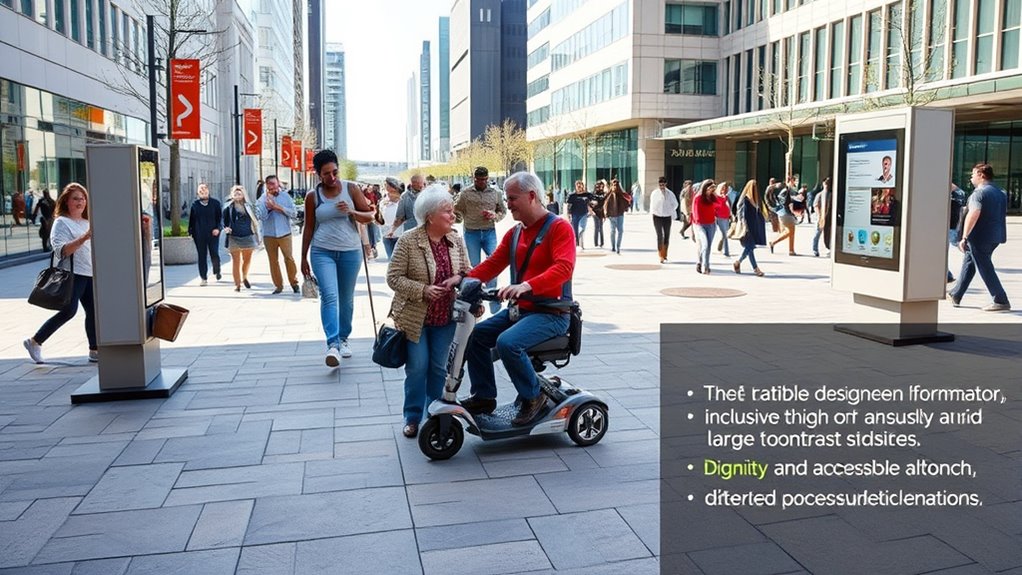Inclusive design principles prioritize your dignity and choice by creating spaces, products, and services that adapt to diverse abilities and preferences. You’ll find features like adjustable interfaces, universal accessibility, and adaptive technology that empower you to navigate independently. This approach eliminates barriers and respects individual differences, fostering a sense of equality and autonomy. By embracing these principles, you help build environments where everyone feels valued and supported—discover how to incorporate these ideas for lasting impact.
Key Takeaways
- Prioritize universal accessibility to create inclusive spaces that accommodate diverse abilities and preferences.
- Incorporate adaptive technologies like voice recognition and adjustable interfaces to empower individual choices.
- Make deliberate design choices such as ramps and wide doorways to respect human diversity and autonomy.
- Use flexible, customizable features to ensure continuous improvement and meet future accessibility needs.
- Focus on fostering environments of dignity and participation, emphasizing ongoing innovation and personal agency.

Have you ever considered how design can be more accessible and welcoming to everyone? When you focus on inclusive design principles, you’re creating spaces, products, and services that respect the dignity and choices of all users. Central to this approach is the idea of universal accessibility, which means designing in a way that accommodates the broadest range of abilities and preferences. Instead of creating separate solutions for different groups, you develop one cohesive experience that everyone can use comfortably. This not only fosters equality but also simplifies user interactions, making navigation intuitive regardless of physical or cognitive differences.
Incorporating adaptive technology is key to achieving true inclusivity. Adaptive tools, like screen readers, voice recognition software, or adjustable interfaces, empower users to customize their experience based on their needs. For example, someone with limited mobility might rely on voice commands, while a person with visual impairments benefits from high-contrast visuals or text-to-speech features. By integrating adaptive technology into your design process, you ensure that individuals retain their dignity and independence, giving them the freedom to choose how they engage with your product or space. It’s about removing barriers and opening up possibilities, not creating new ones.
When you prioritize universal accessibility, you’re also thinking beyond compliance—you’re making deliberate choices that acknowledge the diversity of human experience. This might mean designing buildings with ramps and wide doorways, or creating websites with adjustable font sizes and keyboard navigation. Each decision reflects a commitment to inclusivity and a recognition that everyone deserves equal access. This approach benefits not only those with disabilities but also older adults, parents with strollers, or anyone facing temporary challenges. It’s a way of designing that respects the inherent dignity of every individual and trusts that everyone should have the opportunity to make their own choices.
Furthermore, embracing adaptive technology and universal accessibility often leads to innovative solutions that improve overall user experience. When you think about flexible options and adjustable features, you’re encouraging a mindset of continuous improvement. This mindset helps you anticipate future needs and technological advances, ensuring your design remains relevant and inclusive over time. Additionally, incorporating space and organization strategies from home improvement can inspire more functional and adaptable environments. Ultimately, inclusive design isn’t just about meeting standards; it’s about fostering an environment where all individuals feel valued, respected, and empowered to participate fully. By making intentional choices today, you create spaces and experiences that uphold dignity and champion personal agency for everyone.
Frequently Asked Questions
How Can Inclusive Design Improve User Engagement?
You can boost user engagement by embracing accessibility innovations that make your platform usable for everyone. Incorporate empathy-driven design to understand your users’ needs and preferences, creating a more personalized experience. When users see that your design considers their challenges and respects their dignity and choice, they’re more likely to stay engaged. This approach builds trust, encourages interaction, and fosters a loyal community around your product or service.
What Are Common Challenges in Implementing Inclusive Design?
Imagine building a bridge that only some can cross—that’s what implementing inclusive design feels like. You face accessibility barriers that exclude users with disabilities and cultural considerations that overlook diverse backgrounds. Common challenges include balancing diverse needs, limited resources, and resistance to change. Overcoming these requires understanding user diversity and committing to ongoing adjustments, ensuring everyone can access and engage with your design, just like a sturdy bridge supports all travelers.
How Does Inclusive Design Influence User Trust?
When you prioritize inclusive design, you build user trust by showing cultural sensitivity and adhering to accessibility standards. Your designs become more welcoming and easier to use for everyone, which fosters confidence and loyalty. By actively considering diverse needs and removing barriers, you demonstrate respect and commitment. This transparency and inclusivity encourage users to trust your brand or product, knowing you value their dignity and provide equitable access for all.
Can Inclusive Design Be Cost-Effective for Businesses?
Think of inclusive design as planting a garden; investing in it today yields abundant blooms tomorrow. When you do a thorough cost analysis and consider your budget, you’ll see that inclusive design can be cost-effective, reducing future expenses like redesigns or customer loss. By embracing this approach, you not only enhance user experience but also build loyalty, proving that thoughtful investment pays off in the long run.
How to Measure Success in Inclusive Design Initiatives?
To measure success in inclusive design initiatives, you should focus on accessibility metrics and user satisfaction. Track how easily diverse users access and navigate your products or services, and gather feedback to understand their experiences. If accessibility improves and users report higher satisfaction, you’re on the right track. Regularly analyzing these metrics helps you refine your approach, ensuring your inclusive design truly meets everyone’s needs and promotes dignity and choice.
Conclusion
By embracing inclusive design principles, you become the architect of a world where dignity and choice flourish like a well-tended garden. Every decision you make plants seeds of accessibility, ensuring that everyone can thrive without barriers. Remember, your efforts create ripples that extend far beyond the immediate, transforming spaces into welcoming havens. When you prioritize inclusion, you craft a landscape where everyone’s voice matters, turning the complex mosaic of humanity into a masterpiece of unity and respect.









